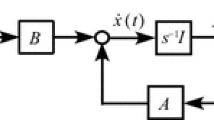Abstract
Electromechanical systems usually have an innate backlash in their gear trains which is normally nonlinear and limits the performance of the system. In this paper, a disturbance observer is designed in order to estimate the properties of the backlash. Generally, such disturbance observers are designed with the inverse model of the nominal plant but since the backlash is an internal factor of the plant, its effect cannot be separated from the system output. In the proposed model, the plant is reconfigured to separate the effects of the backlash from the output, and a new type of disturbance observer is proposed to detect and compensate for the backlash in the remodelled plant. The suggested disturbance observer is applied to the knee joint of a humanoid robot. Using the proposed disturbance observer, it is shown that the backlash can be compensated for, and that the tracking error decreases in the knee pitch trajectory. Also, an error analysis of the input trajectory is carried out to verify the performance of the proposed disturbance observer and the validity of the proposed control scheme is discussed.
Similar content being viewed by others
References
T. Nakamura, “Hydrogen production from water utilizing solar heat at high temperatures,” Solar Energy, vol. 19, pp. 467–475, 1977.
N. Gokon, Hydrogen Energy, Chapter 6, Cambridge University Press, Cambridge, UK, 2000.
H. Tanaka and M. R. Lovell, “On the sliding friction characteristics of unidirectional continuous FRP composites,” ASME Journal of Tribology, vol. 123, no. 2, pp. 15–23, 2002.
Y. Lee, A. Nakamura, and N. Gokon, “Structure of multi-cellular natural convection in a tall vertical annulus,” Proc. 7th International Heat Transfer Conference, U. Grigul et al., eds., Hemisphere, Washington, DC, vol. 2, pp. 222–227, 1998.
M. Yoshida, “600 MW solar thermal technology development,” High Temperature Technology, PVP, vol. 406, pp. 135–140, 2005.
M. Odai and Y. Hori, “Speed control of two-inertia system with gear backlash based on gear torque compensation,” Electrical Engineering in Japan, vol. 134, no. 2, pp. 36–43, 2001.
C. Y. Sato, Evaporative Heat Transfer in the Contact Line of a Mixture, Ph.D. thesis, Rensselaer Polytechnic Institute, Troy, NY, 1999.
K. Nakamura and H. Tanaka, “Prediction of the incompressible flow over a rearward-facing step,” Technical Report, No. HTL-26, CFD-4, Niigata Univ., Niigata, 1998.
N. Gokon, Conformal Lubricated Contact of Cylindrical Surfaces Involved in a Non-Steady Motion, Ph.D. thesis, Niigata University, 2002.
H. J. Kim, A Study on Modeling and Control of Gear System with Backlash, M.S. thesis, KAIST, 2000.
M. Nordin and P. O. Gutman, “Controlling mechanical systems with backlash - a survey,” Automatica, vol. 38, no. 10, pp. 1633–1649, 2002.
T. Umeno, T. Kaneko, and Y. Hori, “Robust servosystem design with two degrees of freedom and its application to novel motion control of robot manipulators,” IEEE Trans. on Industrial Electronics, vol. 40, no. 5, pp. 473–485, 1993.
Author information
Authors and Affiliations
Corresponding author
Additional information
Recommended by Editorial Board member Dong Hwan Kim under the direction of Editor Jae-Bok Song. This work was supported by the Inha University and National Research Foundation of Korea (NRF) grant funded by the Korea government (MEST) (No. 2007-0056386).
Min-Jung Kang received her M.S. degree in Electrical Engineering from Inha University in 2009. She is currently a researcher with the Department of R&D, Taechang N.E.T of Bucheon, Korea. Her research interests are in areas of application of mobile robots, intelligent control, control of wind turbine.
Jong-Hun Park received his M.S. degree in Electrical Engineering from Inha University in 2004. He is now pursuing a Ph.D. degree in the Department of Robot Engineering, Inha University, Incheon, Korea. His current research interests include path planning and Robotics.
Jin-Hwan Kim received his M.S. and Ph.D. degrees in Electrical Engineering from Inha University in 1993 and 1996, respectively. He is currently a professor with the Department of Electrical Engineering, Inha Technical College of Incheon, Korea. His research interests are in the areas of design of fuzzy controller and application of mobile robots.
Uk-Youl Huh received his B.S., M.S., and Ph.D. degrees in Electrical Engineering from Seoul University in 1974, 1978, and 1982, respectively. He is currently a professor with the Department of Electrical Engineering, Inha University, Incheon, Korea. His research interests are in the areas of intelligent control, fuzzy controller design and its application to mobile robot.
Rights and permissions
About this article
Cite this article
Kang, MJ., Park, JH., Kim, JH. et al. A disturbance observer design for backlash compensation. Int. J. Control Autom. Syst. 9, 742–749 (2011). https://doi.org/10.1007/s12555-011-0416-8
Received:
Revised:
Accepted:
Published:
Issue Date:
DOI: https://doi.org/10.1007/s12555-011-0416-8




